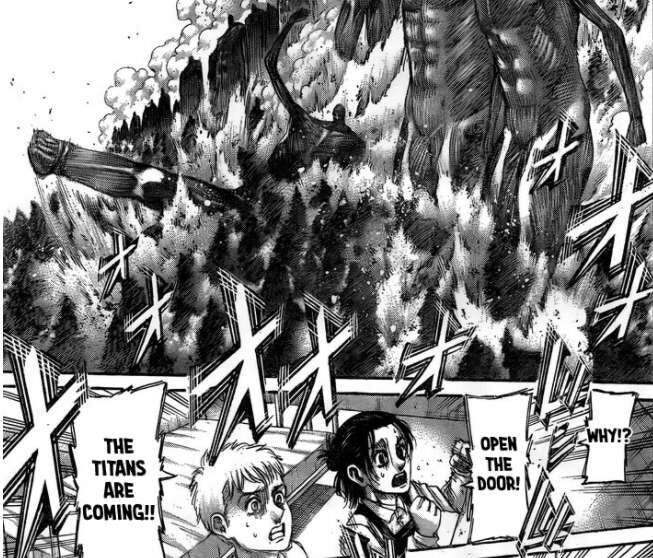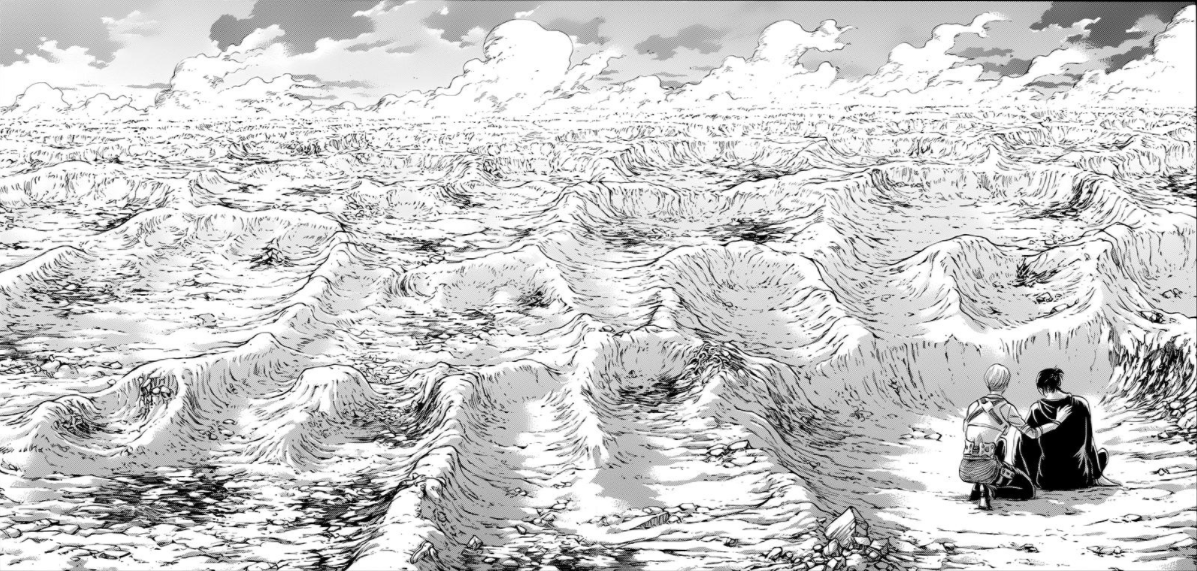The Rumbling is one of the most pivotal events in the "Attack on Titan" universe, igniting debates and excitement among fans. It's not just a plot device; it embodies the very essence of fear, survival, and the struggle for freedom. In essence, the Rumbling refers to the catastrophic march of the Colossal Titans, unleashed as a means of world annihilation. But what drives this phenomenon? Understanding its core motivations is crucial, as it touches upon themes of morality, vengeance, and the cycle of hatred.
The Historical Context of Titans

To fully grasp the implications of the Rumbling, we must dive into the historical context of Titans. The origins of Titans trace back to the Eldian Empire, where they were initially viewed as tools of war. Here’s a breakdown of the significant historical moments:
- Eldian Empire's Rise (Before 2000 years ago): Eldians, led by Ymir Fritz, harnessed the power of Titans to conquer lands, establishing fear and dominance over Marleyans.
- Ymir Fritz's Tragedy: The first Titan, Ymir's tragic tale serves as the backbone of Titan history. Her ability to transform into a Titan was exploited, leading to her eventual betrayal and death.
- The Great Titan War: Marking a turning point, this war resulted in the downfall of the Eldian Empire. Marleyans seized control, leading to the oppression of Eldians.
- Marleyan Oppression: Post-war, Eldians were marginalized, forced into internment zones, and labeled as devils. This historical trauma fuels the anger and desperation seen in characters like Eren Yeager.
Understanding this history reveals how the Rumbling isn't merely an act of destruction; it’s a response to centuries of conflict and oppression. The cycle of violence deeply rooted in this historical context is what drives the characters and their decisions, making the Rumbling a significant culmination of their struggles.
Also Read This: Who Will Be in the 2024 Royal Rumble?
The Role of Eren Yeager in the Rumbling

Eren Yeager is at the heart of the Rumbling, serving as both the catalyst and the driving force behind this cataclysmic event. Initially, Eren's motivations stem from his deep-seated desire to protect his friends and secure freedom for his people. However, as the story unfolds, his perspective shifts dramatically, leading to a more complex and darker rationale.
After learning about the truth of the Titans and the world outside Paradis, Eren becomes disillusioned with the cycle of hatred and violence. He decides that the only way to secure peace is through annihilation of the Titans and those who threaten his people. This shift in strategy is pivotal; the Rumbling becomes a means to an end for Eren, showcasing his transformation from a hopeful hero to a more ambiguous anti-hero.
One of Eren's most significant actions is activating the Rumbling by unleashing the power of the Founding Titan. This act triggers the colossal Titans that were dormant within the walls of Paradis, setting them on a path of destruction across the world. Eren’s decision to unleash this catastrophic force is a reflection of his belief that only through overwhelming strength can he achieve the freedom he craves.
Ultimately, Eren’s role in the Rumbling raises important questions about morality, freedom, and the cost of peace. Is he a villain, or is he merely a product of his circumstances? Eren's choices challenge the viewers’ perceptions, prompting them to reflect on the nature of justice and sacrifice.
Also Read This: How Strong Is the Rumble Fruit in Blox Fruits and How to Use It Effectively
Key Characters and Their Motivations
The Rumbling is not just a consequence of Eren's actions; it involves a complex web of characters, each with their unique motivations that contribute to the unfolding chaos. Understanding these characters helps to grasp the emotional weight and moral dilemmas present in the series.
Eren Yeager: As mentioned, Eren’s transformation from a hopeful protagonist to a dark figure is driven by his desire for freedom and his belief that violence is necessary for peace. His internal conflict makes him a deeply relatable character, despite his drastic actions.
Mikasa Ackerman: Eren's childhood friend and protector, Mikasa’s motivations are tied to her unwavering love for Eren. She grapples with the conflict between her loyalty to him and the moral implications of his choices. Her journey highlights themes of love, loss, and the struggle to maintain one's principles in the face of overwhelming odds.
Armin Arlert: Armin serves as a voice of reason among his friends. His motivation lies in finding a peaceful solution, contrasting with Eren's destructive path. Armin’s character represents hope and the belief in dialogue and understanding as alternatives to violence.
Reiner Braun: Initially an antagonist, Reiner embodies the complexity of the conflict. His motivations stem from a desire for acceptance and belonging, torn between his role as a warrior and his empathy for the people of Paradis. Reiner's struggle illustrates the gray areas of morality in war.
These characters, along with others like Levi Ackerman and Historia Reiss, create a rich tapestry of motivations that complicate the narrative. Their interactions and conflicts drive the emotional core of the story, challenging viewers to question what they would do in similar situations.
Also Read This: When Is the Next Royal Rumble? Date and Schedule for Upcoming Events
The Political Landscape of Paradis Island
The political landscape of Paradis Island is a complex tapestry woven with threads of power, fear, and survival. At the heart of the conflict are the walls that protect the inhabitants from the Titans outside, but within those walls, a different kind of warfare is brewing. The ruling monarchy, represented by the royal family, seeks to maintain control over the Eldians who live in ignorance of the world beyond their borders. However, factions like the Survey Corps and the Warriors challenge this status quo.
One significant aspect of this political dynamic is the struggle between the desire for freedom and the weight of history. The Eldians, burdened by their past sins, are often portrayed as both victims and oppressors. This duality creates tension within the government of Paradis Island, as leaders grapple with how to navigate their identity and their future.
- The Royalists - They believe in maintaining the status quo and protecting the island at all costs.
- The Survey Corps - A group that fights for exploration and understanding of the outside world, often pushing against royal authority.
- The Warriors - They represent a faction from Marley, aiming to exploit the Eldians for their own ends, further complicating the political landscape.
This intricate web of alliances and betrayals makes the political landscape of Paradis Island a driving force behind the narrative, forcing characters to make often heartbreaking choices that echo throughout the series.
Also Read This: WWE Royal Rumble 2024 Start Time and Complete Schedule
Thematic Implications and Moral Dilemmas
One of the most compelling aspects of "Attack on Titan" is its exploration of deep thematic implications and moral dilemmas. The series doesn’t shy away from asking hard questions about freedom, oppression, and the nature of humanity. For instance, the fight for freedom often leads to violent consequences, prompting viewers to ponder whether the ends justify the means.
The idea of "survival of the fittest" surfaces repeatedly, forcing characters and audiences alike to reflect on their values. For example, characters like Eren Yeager face the moral dilemma of sacrificing their own humanity for the greater good of their people. This conflict is mirrored in the choices of the Marleyan forces, who view the Eldians as tools rather than human beings.
| Themes | Examples |
|---|---|
| Freedom vs. Oppression | The constant struggle against Titans and Marleyan control. |
| Identity | Eldians grappling with their past and its implications on their future. |
| Moral Ambiguity | Characters making choices that blur the line between right and wrong. |
Ultimately, "Attack on Titan" challenges us to confront uncomfortable truths about our own world, making it not just a story about survival, but a profound commentary on the human condition.
Understanding the Causes of the Rumbling in Attack on Titan
The Rumbling is a pivotal event in the "Attack on Titan" series, representing both a catastrophic force and a desperate measure. It involves unleashing the Colossal Titans that reside within the walls, and it serves as a powerful narrative device that explores themes of freedom, fear, and the lengths to which humanity will go for survival. The causes of the Rumbling can be categorized into several key factors:
- Historical Context: The Rumbling stems from the history of Eldians and their oppression. The fear of Eldians as Titan-shifters leads the Marleyan government to seek control through violence and discrimination.
- Power of the Founding Titan: Eren Yeager's ability to access the Founding Titan’s powers plays a crucial role. This ability allows him to command the Colossal Titans within the walls.
- Desperation for Freedom: Eren's desire to protect his friends and secure freedom for Eldians drives him toward this extreme action. He believes that the Rumbling is the only way to ensure their survival against Marley.
- Influence of the Past: The tragic history of the Titans and the cycle of hatred between Eldians and Marleyans create a backdrop that shapes the motivations behind the Rumbling.
Moreover, these causes intertwine with personal motivations of the characters involved, making the Rumbling a complex and multi-layered event. Its implications extend beyond mere destruction, symbolizing the harsh realities of war and the moral dilemmas faced by those involved.
Conclusion and Final Thoughts
The Rumbling in "Attack on Titan" is a manifestation of deep-rooted historical grievances, personal motivations, and the desperate quest for freedom, ultimately making it a poignant commentary on human nature and conflict.
 admin
admin








